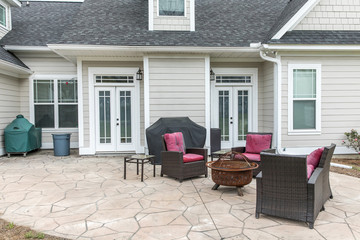In addition to adding a unique aesthetic to outdoor spaces, stamped concrete is also a cost-effective alternative to other cladding materials. It can mimic the look of fractured earth, real stone, and wood at a fraction of the price.

Concrete contractors uses large, flexible rubber urethane stamps to create the textured finish. These are sprayed with color-release powder before stamping.
When it comes to aesthetics, stamped concrete is hard to beat. It has a natural look that complements any landscaping and can make a dramatic impact on the overall appearance of your home’s exterior. Moreover, it’s a cost-effective alternative to pavers and can be used for walkways, patios, pool decks, driveways, and even interior floors. It’s easy to maintain and can last for decades with proper care and cleaning.
Stamped concrete is a decorative finish for new or old concrete that is pressed with large rubber stamps to create a textured surface. It can be made to resemble natural stone, cobblestone, tile, brick, wood planks, or slate. The concrete is colored before it’s poured, or the color can be added later with a special coating. In either case, the final result is a stylish surface that looks like it was expensively installed with natural pavers or stonework.
Modern stamped concrete is available in an endless variety of patterns and colors to match any style of home. Many homeowners choose a pattern that reflects the surrounding landscape or the home’s architectural style. Others find inspiration from a favorite piece of artwork or furniture and use this as the basis for their color selection.
The most popular choice for stamped concrete is a natural stone pattern. Slate, flagstone, and fieldstone are the most common choices, but there are also options resembling tile, brick, or cobblestone. The most common colors for stamped concrete are grays and earth tones, but stains and tints are available in virtually unlimited possibilities.
One of the most important aspects of a successful stamped concrete project is choosing the right contractor. You want to hire a company that has experience with this type of work and has examples to show you. Also, look for a contractor who offers a warranty on their work.
Once the stamped concrete is finished, it must be sealed to protect it from abrasion and other damaging elements. It is recommended that the sealer be reapplied every two to three years. It is also a good idea to avoid using harsh chemicals, such as de-icers and oil-based cleaners, on the sealed surface.
Durability
Concrete is a durable material that can withstand the elements, heavy foot traffic, and more. When the right mixture and installation process are used, stamped concrete can last for years. It can also be a cost-effective alternative to other paving materials.
Stamped concrete is versatile and customizable to your unique aesthetic. It can mimic the look of many different materials, including stone, wood, brick, and tiles. It can be a great choice for pool decks, patios, driveways, and more. However, it’s important to choose a reliable contractor who has experience with this type of work.
The concrete must be mixed with the correct ratio of cement, water, and aggregates to achieve the proper strength and density. If the mixture isn’t prepared correctly, it may crack or not have a smooth finish. It’s also important to choose the right color. Stamped concrete colors tend to lean towards earth tones, but they can be customized to match the colors of your home and landscaping.
Like all paving materials, stamped concrete will eventually crack. However, if it’s installed properly by a professional, the cracks can be hidden from view with a good coloring and resealing job. It’s also important to maintain your stamped concrete on a regular basis to keep it looking its best. Efflorescence, weathering, and dirt can cause the color to fade over time, but this is easy to fix by cleaning and resealing.
If you’re interested in creating a beautiful and eye-catching patio, driveway, or other outdoor space, stamped concrete may be the perfect option for you. With a variety of patterns and colors to choose from, you’ll be sure to find the perfect look for your space. Plus, stamped concrete is affordable and easy to maintain, making it a great option for any homeowner.
Maintenance
Stamped concrete is an excellent option for patios, driveways, and pool decks. It is long-lasting and easy to maintain. In fact, it requires less maintenance than most paving materials, such as natural stone and wood. However, to keep stamped concrete looking its best, regular cleaning is important. It is also a good idea to get the concrete resealed every two years. Resealing keeps the concrete protected from water, chemicals, and stains.
To avoid stains, sweep the concrete regularly to remove dirt and debris. It is also a good idea to remove any material that tends to pile up, like leaves, tarps, and garbage bags. It is important to prevent grime from building up on the concrete because it can cause permanent damage. If the concrete is already stained, you should use a power washer on a low setting to wash away the grime. Be sure to follow the manufacturer’s instructions on the product you use, as some cleaners can damage the concrete.
Concrete is an extremely durable material, but it can be damaged by harsh weather conditions. For example, freezing temperatures can cause concrete to crack. Moisture from ice and snow can seep into small cracks and expand as the temperature changes, causing the crack to grow larger. If this happens, a local concrete contractor should be called to repair the damage.
In addition to regular cleaning, it is a good idea to train your pets not to relieve themselves on the concrete. Their urine is quite acidic and could damage the concrete over time. You should also not drag any equipment or furniture onto the concrete. The sharp metal edges can scratch and chip the concrete surface. You should also refrain from using deicing agents on the concrete, as they can eat through the surface and leave behind white stains that are difficult to remove. For a professional, affordable solution to your concrete needs, contact Maddox Concrete, LLC, today. We offer a variety of services, including concrete stamping and resurfacing. We have years of experience and are dedicated to helping our clients make their homes and businesses beautiful.
Cost
The cost of stamped concrete depends on the type and size of the project. The most common types of projects are patios and walkways, but they can also include driveways and pool decks. The cost of the materials used to make the concrete will influence the final price, but installation and labor costs can add up as well. It is important to consult a professional for an accurate estimate of the total cost. The contractor will help you choose a style that will match the surrounding landscaping and home, which can lower the overall cost.
Stamped concrete can mimic the look of other types of paving materials, such as flagstones, cobblestone, and brick. However, it is much less expensive than those materials and has the added benefit of longevity. It is also easier to maintain than pavers, which can become loose or shift over time, causing tripping hazards.
Concrete can be stained and colored to achieve a wide variety of designs and colors. The most popular color options are earth tones, but you can even create a pattern that mimics wood or tiles. The color can be embedded in the concrete during construction or added later, depending on your preference.
Aside from color, stamped concrete can be made slip-resistant by adding an additive during the mixing process. This additive makes the surface more grippy and can reduce the risk of accidents in wet conditions. The addition of this material can also reduce the chance of cracking due to movement or freezing and thawing.
The durability of stamped concrete will depend on the type of concrete used, its thickness, and how it is installed. Most residential concrete has a grade of M10, M15, or M20, which is adequate for most walkways and patios. However, a heavier-duty grade is required for load-bearing projects such as driveways.
The price of stamped concrete will vary depending on the type and size of the project, as well as the finishing and sealing options chosen. Standard stamps are cheaper than custom designs, and installation costs will increase with the complexity of the job. Staining and sealants can add up as well, with prices varying by brand, hardness, tint, UV-protection level, and matte vs. shiny finishes.


